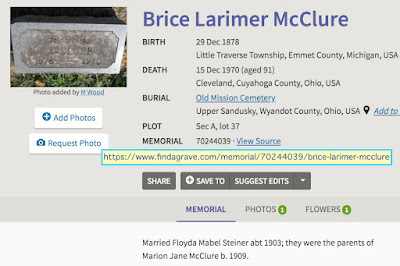One of my passions is to keep family history alive for the sake of future generations and for future researchers. After years of research, I'm sharing what I know
now by posting bite-sized ancestor biographies on multiple websites.
This is part of the PASS process described in my updated book, Planning a Future for Your Family's Past (available on Amazon, in the book store at American Ancestors.org, and in the book store at the Newberry Library).
Lots of copies keep stuff safe
At top, the bite-sized bio I wrote about my husband's maternal grandfather, Brice Larimer McClure (1878-1970). After sharing within the family, I've posted this on Family Search, My Heritage, and WikiTree. The idea is to share this ancestor's story widely, in public, so those who come after can learn more about his life.
I'm applying the LOCKSS principle--the concept that "lots of copies keep stuff safe." With lots of copies, it's less likely that genealogical and biographical information will be forgotten or lost or otherwise become inaccessible as time goes on.
Not yet on Find a Grave
For the past year, I've been trying--unsuccessfully--to have this ancestor's bio posted to the memorial page on Find a Grave.
Find a Grave is free, it's worldwide in scope, and it's another suitable place to share info about ancestors.
Image at right shows how the memorial page currently looks. Notice that I took the photo of Brice's grave and posted it years ago.
The brief bio currently on the page was not written by me. It's not just incomplete, it's inaccurate.
I've posted other ancestral bios on Find a Grave, both on memorial pages that I manage and through the courtesy of non-relatives who manage my ancestors' pages. However, I haven't yet been able to get Brice's posted.
Following Find a Grave's policies
Beginning in January of 2021, I submitted edits multiple times to the current manager of this memorial. Repeatedly. To date, I've had no response. I see the current manager has more than 440,000 memorials, and that person's profile mentions how much time it takes to plow through edits and requests for transfer.
Still, 13 months seems way too long to wait for edits to be posted or a transfer to be completed (with a click). I've even explained to the current manager, at least once, that Brice and Floyda are my husband's maternal grandparents.
According to Find a Grave's policies, someone who manages a memorial page that is NOT of their ancestor is supposed to transfer to a relative, upon request. You can read those policies here.
Now I'm giving Find a Grave an opportunity to stop the 13-month logjam and expedite the transfer of Brice's and Floyda's pages to me. I wrote the support folks, as Find a Grave says to do, and briefly explained why I want to manage those memorial pages and how I've attempted to have accurate bios posted for months, to no avail.
(March 8 update: No response yet) (March 21 update: Find a Grave said, in a tweet: "We are processing a large backlog at this time. We apologize in advance for a delay in response; we are responding as soon as we can. Thank you for your patience while we process the mail we have received. Please know we are giving each request our full attention."
March 29 update: Partial success!! Find a Grave made me the manager of my Dad's memorial. Now I'm hoping they'll transfer hubby's grandparents in just as timely a manner. TY to Find a Grave.
My goal is to keep alive the memory of these ancestors, not just for descendants but also for other genealogical researchers. And I don't give up easily! Readers, I'll keep you posted about what happens.























